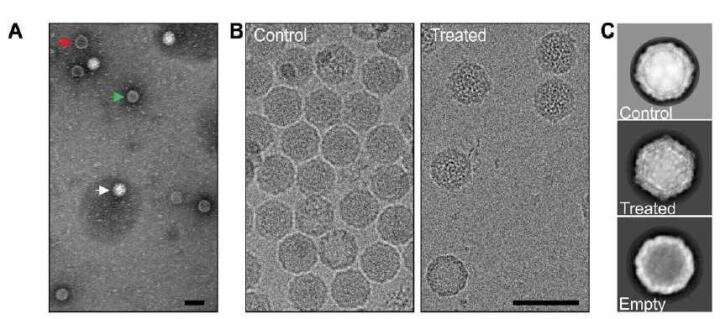Physiological mechanisms leading to enterovirus opening revealed

Enteroviruses are one of the most common human pathogens leading to high number of acute and chronic infections worldwide. The physiological events leading to successful enterovirus infection are still poorly understood. Researchers at the Nanoscience Center at the University of Jyväskylä and at the University of Helsinki have found significant new information concerning the role of Albumin and ions in host cell vesicles that promote genome release and efficient infection. The results may yield targets for therapeutic development. The research was published in the Journal of Virology in August.
Especially the molecular factors that help enteroviruses to open up and release its genome in human cells are not well understood.
Using real-time uncoating measurements and high-resolution structures, a research team comprised of docent Varpu Marjomäki´s group (Nanoscience Center at the University of Jyväskylä) and professor Sarah Butcher´s group (University of Helsinki) found that the common molecule in serum and interstitial fluids, albumin, and an ion composition that is typically developed in cellular vesicles, trigger expansion of the virion.
This expanded and fenestrated virus then allows more small molecules such as ions to enter the virus. The results of this study suggest that before entering cells, albumin primes the virus to form a metastable yet infectious intermediate particle. Then, ionic changes that are likely to occur in cellular vesicles further contribute to opening and promote release of the genome.
"The successful release of the genome is one of the rate-limiting steps in virus infection. It needs to occur in the right place in the right time to ensure efficient infection. This work provides new insight into understanding this fundamental aspect of enterovirus life cycle and may yield targets for therapeutic development," says docent Varpu Marjomäki from the Nanoscience Center at the University of jyväskylä.
More information: Visa Ruokolainen et al. Extracellular Albumin and Endosomal Ions Prime Enterovirus Particles for Uncoating That Can Be Prevented by Fatty Acid Saturation, Journal of Virology (2019). DOI: 10.1128/JVI.00599-19
Journal information: Journal of Virology
Provided by University of Jyväskylä


















